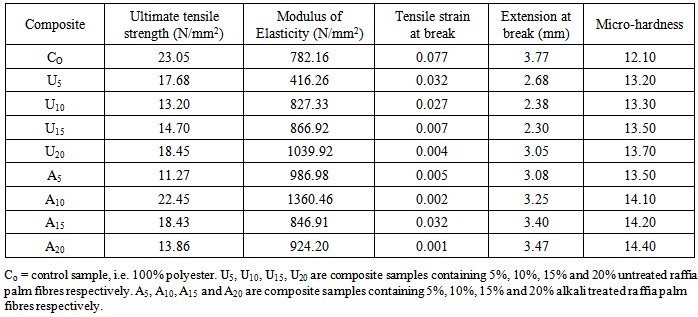-
Paper Information
- Previous Paper
- Paper Submission
-
Journal Information
- About This Journal
- Editorial Board
- Current Issue
- Archive
- Author Guidelines
- Contact Us
American Journal of Polymer Science
p-ISSN: 2163-1344 e-ISSN: 2163-1352
2014; 4(4): 117-121
doi:10.5923/j.ajps.20140404.03
The Effect of Alkali Treatment on the Tensile Behaviour and Hardness of Raffia Palm Fibre Reinforced Composites
D. C. Anike1, T. U. Onuegbu1, I. M. Ogbu2, I. O. Alaekwe1
1Department of Pure and Industrial Chemistry, Nnamdi Azikiwe University Awka, Anambra State, Nigeria
2Department of Chemistry Federal University Ndufu-Alike, Ikwo Ebonyi State, Nigeria
Correspondence to: D. C. Anike, Department of Pure and Industrial Chemistry, Nnamdi Azikiwe University Awka, Anambra State, Nigeria.
| Email: |  |
Copyright © 2014 Scientific & Academic Publishing. All Rights Reserved.
The effects of alkali treatment and fibre loads on the properties of raffia palm fibre polyester composite were studied. Some clean raffia palm fibres were treated with 10% NaOH, and ground. The ground treated and untreated fibres were incorporated into the ortho unsaturated polyester resin. The treated and the untreated fibre composites samples were subjected to tensile tests according to ASTM D638 using instron model 3369. The microhardness test was done by forcing a diamond cone indenter into the surface of the hard specimen, to create an indentation. The significant findings of the results showed that alkali treatment improved the microhardness and extension at break at all fibre loads, better than the untreated fibre composites, with the highest values at 20% (14.40 and 3.47mm for microhardness and extension at break respectively). Tensile strength, tensile strain and modulus of elasticity also improved for alkali treated fibre composites, except in 5% and 20% for tensile strength, 15% for tensile strain, and 15% and 20% for modulus of elasticity, compared to the corresponding fibre loads of untreated fibre composites.
Keywords: Raffia palm fibre, Composite, Ortho unsaturated polyester, Alkali treatment
Cite this paper: D. C. Anike, T. U. Onuegbu, I. M. Ogbu, I. O. Alaekwe, The Effect of Alkali Treatment on the Tensile Behaviour and Hardness of Raffia Palm Fibre Reinforced Composites, American Journal of Polymer Science, Vol. 4 No. 4, 2014, pp. 117-121. doi: 10.5923/j.ajps.20140404.03.
Article Outline
1. Introduction
- The application of natural fibres as replacement to conventional or artificial fbres in fibre-reinforced polymer composites has received increased attention in industries, and academic institutions, as well [1]. Natural fibres have many significant advantages over synthetic fibres. Currently, many types of natural fibres have been investigated for use in plastics. These include flax, hemp, jute straw, wood, rice husk, wheat, barley, oats, rye, cane (sugar and bamboo), grass, reeds, kenaf, ramie, oil palm empty fruit bunch, sisal, coir, water, hyacinth, pennywort, kapok, paper mulberry, raphia, banana fibre, pineapple leaf fibre and papyrus [2]. The growing interest in using natural vegetable fibers as a reinforcement of polymeric based composites is mainly due to their renewable origin, environmental friendliness, biodegradability, abundantly available, cheap and low density [3-5]. The reinforcement of polyester with various cellulosic fibers has been widely reported [2]. Rajulu et al. used bamboo fibers as reinforcement with epoxy/unsaturated polyester blend and studied the tensile properties and chemical resistance of the resulting composites [6]. The main drawbacks of such composites are their water sensitivity, their relatively poor dimensional stability, the changing of fiber characteristics with origin, poor adhesion to basically all matrix polymers, and poor processability at high fiber contents [7]. All plant-derived cellulose fibers are polar and hydrophilic in nature, mainly as a consequence of their chemical structure [8]. Chemical pretreatment of the natural fibre can help to overcome such drawbacks to enhance the compatibility between fibre and the matrices, resulting in improved performance of fibre-reinforced composites [9]. Natural fibres have a good potential for chemical treatment due to presence of hydroxyl groups in lignin and cellulose. Reaction of hydroxyl groups can change the surface energy and the polarity of the natural fibres [8]. In pretreatment of natural fibre, either the hydroxyl groups get activated or new moieties are added that can effectively interlock with the matrix [10]. Different surface treatment methods such as mercerization (alkali treatment), isocyanate treatment, acrylation, benzoylation, latex coating, permanganate treatment, acetylation, silane treatment and peroxide treatment have been applied on the fibre to improve its strength, size and its shape and the fibre-matrix adhesion [11].Alkali treatment of natural fibres is known to improve the stiffness, strength, and dynamic flexural moduli of the composites, indicating an increased interfacial bond strength and adhesion between the matrix and the fibres [12]. lkaline processing directly influences the cellulosic fibril, the degree of polymerization and the extraction of lignin and hemicellulosic compounds [13].The aim of this work is to investigate the effect of alkali treatment on tensile properties and microhardness of raffia palm fibre ortho-unsaturated polyester composites.
2. Materials and Methods
2.1. Material
- The raffia palm fibres were collected from raffia palm trees around a stream at Emene, Enugu state. The ortho-unsaturated polyester resin, methyl ketone peroxide, MEKP (catalyst) and cobalt octoate (accelerator) were bought from Polyconsult venture (25 ogunleti street), Ojota Lagos.
2.2. Methods
- a) Preparation of materialsThe pinnate leaves of the raffia palm (Raphia) were pulled out from the leaf stalks. Thereafter, the raffia fibres were taken off from the pinnate leaves. The fibres were washed thoroughly and allowed to dry under the sun.b) Chemical Pretreatment of the FibresThe raffia palm fibres were divided into two (2) portions. One portion was treated using alkali treatment method; also know as mercerization, while the other portion was left untreated.Alkali Treatment (Mercerization)The clean raffia palm fibres were soaked in 10% NaOH solution for I hour at 30℃. Later, the alkaline treated fibres were washed thoroughly in plentiful of distilled water to remove the excess NaOH (or non reacted alkali). The fibres were drained and sun dried.Thereafter, the fibres (alkali treated and untreated) were taken to electric oven, where they were oven-dried at 70℃ for 2 hours. The oven-dried fibres were ground into small particle sizes. c) Preparation of the CompositePolyvinyl Alcohol (PVA), was first applied on all the surfaces of the mould, and allowed to dry. A thin film was formed on the mould when the PVA dried. The film formed acts as the mould releasing agent. Thereafter the unsaturated polyester resin was mixed with different loads of the raffia palm fibres, following the procedure below.First, the unsaturated polyester resin was weighed in a glass beaker, using a digital weighing balance. 2% (by weight of the polyester) of the catalyst, methyl ethyl ketone peroxide (MEKP) was added and the mixture was stirred for 2 mins. After which, 1% (by weight of the polyester) of the accelerator cobalt octoate, was added and stirred for additional 2 mins. The fibre was then added gradually and stirred properly until a homogenous mixture was observed. Then, the prepared formulation was poured into the mould, and allowed to cure for one hour. When fully hardened, the composites were carefully removed from the mould and the overflow flakes were trimmed off. The procedure above was repeated for all the fibre loads of 5%, 10%, 15% and 20%, both for the alkali treated and untreated fibres. The formulation used is shown in table 1.
|
2.3. Characterization of the Samples
- Tensile Tests: Test for tensile test was done using Instron Universal testing machine (3369 model), as described in ASTM method D638.Each tensile specimen was positioned in the Instron Universal tester and then subjected to tensile load. As the specimen stretches, the computer generates the graph as well as all the desired parameters properties of the specimen fractures. The various properties determined include; ultimate tensile strength, modulus of elasticity, tensile strain, extension at breaks. Microhardness test: The hardness test was carried out using microhardness tester, LECO/M700AT. The test was done by forcing a diamond cone indenter into the surface of the hard specimen, to create an impression.
3. Results and Discussion
- The test results of the tensile properties and the microhardness of the composite samples are shown in table 2, and fig 1-5.
|
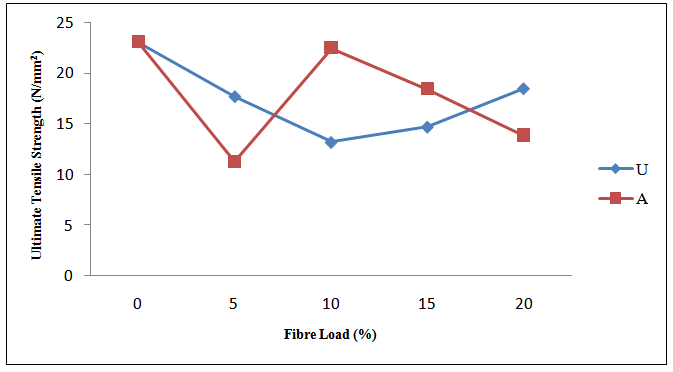 | Figure 1. Effect of Fibre Loads on tensile strength |
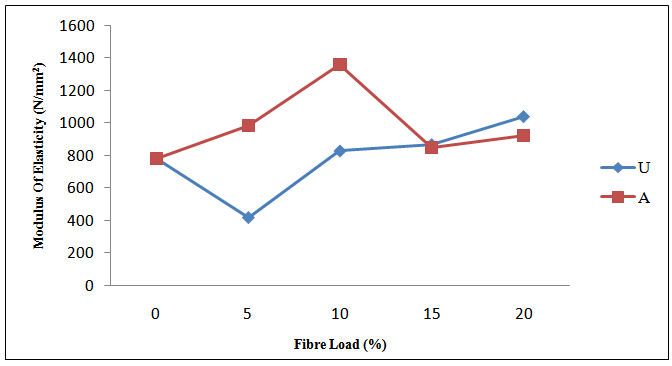 | Figure 2. Effect of Fibre Loads on modulus of elasticity |
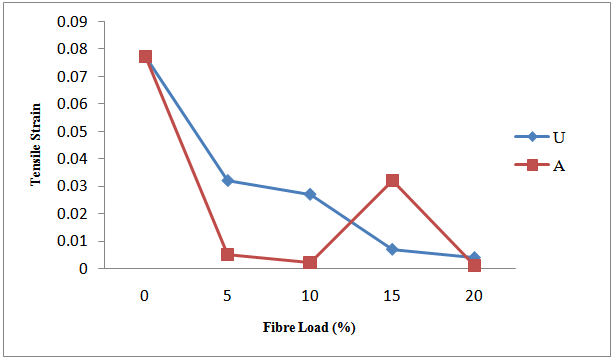 | Figure 3. Effect of Fibre Loads on tensile strain |
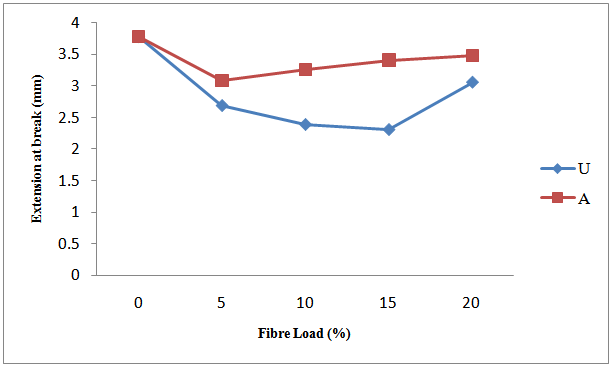 | Figure 4. Effect of Fibre Loads on Extension at Break |
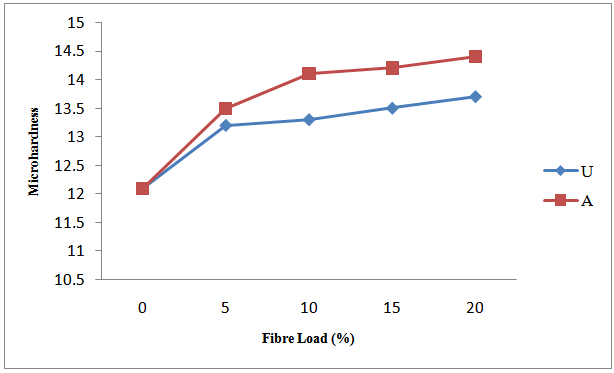 | Figure 5. Effect of Fibre loads on the Microhardness |
4. Conclusions
- From the results obtained, it can be established that the alkali treated fibre showed better reinforcing properties than the untreated fibre, for almost all the properties studied. At all corresponding fibre loads, the extension at break, as well as the microhardness results of alkali treated composites, improved better than the untreated ones. Only the alkali treated fibre composites of 10% and 15% gave improved tensile strength than the corresponding untreated fibre composites. For modulus of elasticity, 10% fibre load gave the highest value (1360.46N/mm2) for treated fibre composite.
5. Recommendations
- We recommend that raffia palm fibre should be implored as natural fibre for reinforcement, but that large set of samples (many different fibre loads), and that short particle length of the fibre, instead of ground ones be considered.
ACKNOWLEDGEMENTS
- The authors wish to thank the staff of Engineering Material Development Institute, Akure where the samples were prepared and characterized.
 Abstract
Abstract Reference
Reference Full-Text PDF
Full-Text PDF Full-text HTML
Full-text HTML
